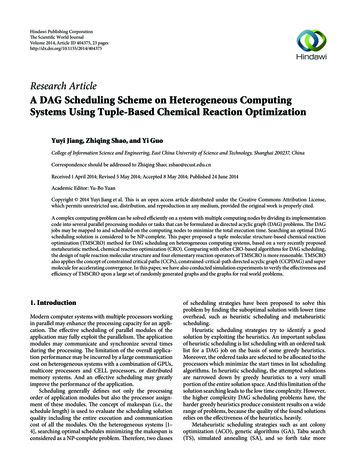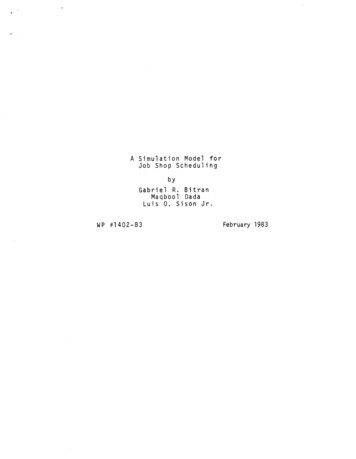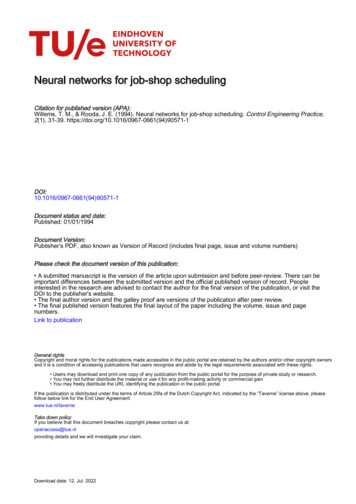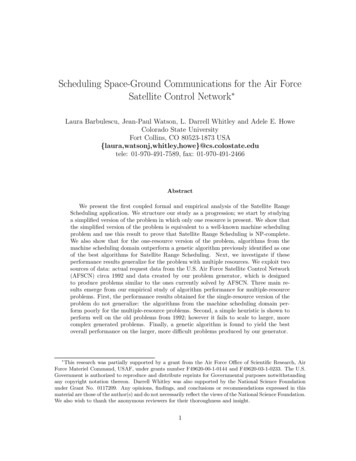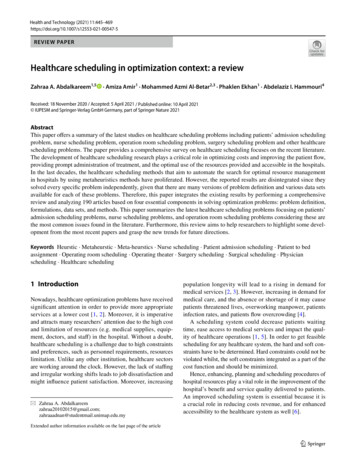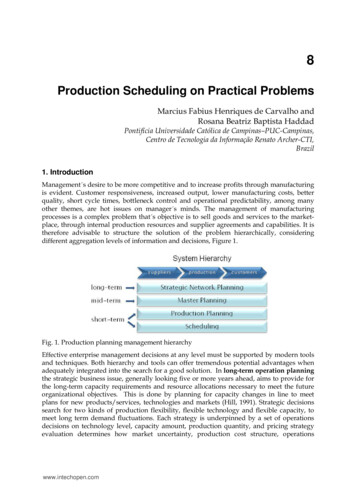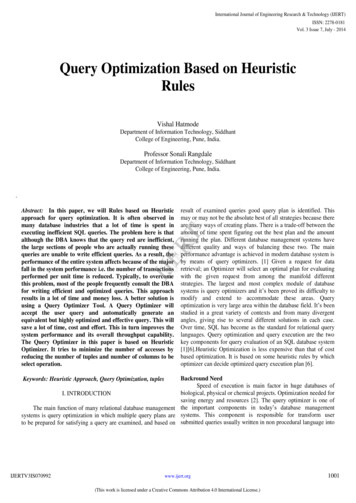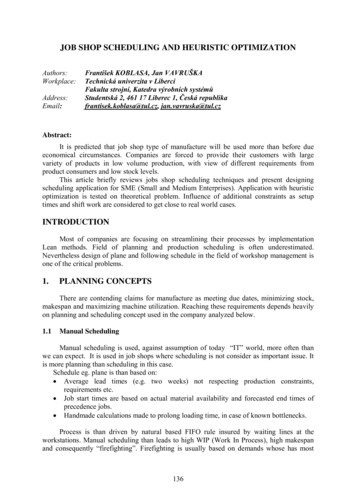
Transcription
JOB SHOP SCHEDULING AND HEURISTIC šek KOBLASA, Jan VAVRUŠKATechnická univerzita v LiberciFakulta strojní, Katedra výrobních systémůStudentská 2, 461 17 Liberec 1, Česká republikafrantisek.koblasa@tul.cz, jan.vavruska@tul.czAbstract:It is predicted that job shop type of manufacture will be used more than before dueeconomical circumstances. Companies are forced to provide their customers with largevariety of products in low volume production, with view of different requirements fromproduct consumers and low stock levels.This article briefly reviews jobs shop scheduling techniques and present designingscheduling application for SME (Small and Medium Enterprises). Application with heuristicoptimization is tested on theoretical problem. Influence of additional constraints as setuptimes and shift work are considered to get close to real world cases.INTRODUCTIONMost of companies are focusing on streamlining their processes by implementationLean methods. Field of planning and production scheduling is often underestimated.Nevertheless design of plane and following schedule in the field of workshop management isone of the critical problems.1.PLANNING CONCEPTSThere are contending claims for manufacture as meeting due dates, minimizing stock,makespan and maximizing machine utilization. Reaching these requirements depends heavilyon planning and scheduling concept used in the company analyzed below.1.1Manual SchedulingManual scheduling is used, against assumption of today “IT” world, more often thanwe can expect. It is used in job shops where scheduling is not consider as important issue. Itis more planning than scheduling in this case.Schedule eg. plane is than based on: Average lead times (e.g. two weeks) not respecting production constraints,requirements etc. Job start times are based on actual material availability and forecasted end times ofprecedence jobs. Handmade calculations made to prolong loading time, in case of known bottlenecks.Process is than driven by natural based FIFO rule insured by waiting lines at theworkstations. Manual scheduling than leads to high WIP (Work In Process), high makespanand consequently “firefighting”. Firefighting is usually based on demands whose has most136
critical delay of due time or makespan. Giving the highest priority to this demand withoutknowing consequences to schedule delay usually more jobs than one.Usual solutions are incretion of work capacity, which leads to greater schedulingproblem, or converting from job shop to product oriented processing line, which leads tosmaller variability of production system and higher production cost.1.2White boards and spreadsheet programsMany companies are still use whiteboards for production scheduling purpose. Thismethod could is sufficient for small and simple production systems. But, it is not practical forscheduling large amount of diverse jobs. Many software vendors extended the whiteboardconcept by offering an electronic version, which offers manual schedule construction andmodifications on Gantt chart (on computer screen).The most used application of electronic whiteboard is thanks to Excel spreadsheet. Theapplications are designed to make feasible schedule thanks to possibilities given by VBA(Visual Basic for Applications). However, scheduling complexity of many job shops is sohigh that Excel applications fail to meet the requirements for quick rescheduling and what-ifanalysis. A significant disadvantage of Excel applications for scheduling hundreds of diversejobs is the large execution time needed for generating a feasible and meaningful schedule.Following disadvantage is time cost of possible optimization algorithms.1.3Scheduling in resource planning environmentImplementations of sophisticated enterprise-wide integrated information systems, whichare known as ERP (Enterprise Resource Planning) systems, are really popular. Companies areable to handle all their information very easily and improve the efficiency of businessoperations with the help of these systems. The utility of ERP systems has further increased inmanufacturing execution due to the integration of shop floor data collection systems with acentral database. From a customer relations point of view, these systems enable the industriesto promptly give their customers real-time job status.1.3.1 ERP/APS and MESHowever systems, based on MRP (material resource planning) are not capable of jobshop scheduling. Problems with production scheduling are usually solved by beforementioned spreadsheet planners or APS (Advanced planning and scheduling) systems.These systems which get data about shop floor model from TPM (TechnologicalPreparation of Manufactory) e.g. BOMs (Bill Of Materials) sometimes provide foramensunfeasible schedules and they are force to repair schedule themselves. Without knowledge ofjob shop scheduling is drag and drop rescheduling quiet time consuming.Powerful ERP/APS, while securing material availability, are usually based on classicalscheduling priority rules as customer demand and SPT (Shortest Processing Time) or MWKR(Most WorK Remaining) [1], without possible foreman intervention securing feasibleschedule in one side and disabling possible schedule optimization on other side.Great problem of APS systems is area of use. APS system is often used in the long termscheduling due high cost of APS and time span of scheduling whole manufacture. Foremanhas little influence to this schedule. MES (Manufacturing Execution Systems) are suitable forlocal optimization of detailed schedules in workshops and they use ERP information as APSsystems.137
1.3.2 TOC schedulingOne of the methods for production scheduling in complex job shop is Drum-BufferRope (DBR) method of the TOC (Theory Of Constraints). DBR scheduling method is basedon assumption that a production system has a single resource constraint and the otherresources have sufficient capacity to fully support any feasible schedule on the constraintresource.DBR concerns with a single constraint resource enables foreman to schedule jobs on theconstraint resource ignoring the capacity of all non-constraint resources. It is not alwayspossible in the complex job shop due shifting bottlenecks. However one of most usedschedule optimization tools is OPT (Optimized Production Technology) system, which isscheduling in scope of DBR method. OPT optimize lot sizes and sequences of jobs on criticalconstraint (e.g. bottleneck) thanks to knowledge of the machining model as alternativetechnological orders, interchangeability of machining devices and sequence dependent setuptimes. Scheduling problem in view of TOC is also solved with large variety of shiftingbottlenecks algorithms [2][3][4].1.3.3 Lean TPS schedulingTPS (Toyota Production System) is world-class production system, which developedand put in practice many concepts, principles, practices and methods Heijunka together withKanban is suitable for controlling repetitive production, prevents lack of work at bottleneckwork places and reduce large inventory at any work place by regulating the material flowthrough the production system. Kanban based systems are not very suitable to solvescheduling of job shop based manufactory systems in other side. Kanban system cannotprovide the predictability of workflow and job completion times for job shops with diversejobs that move through different sequences of work centers. It is useful for productionmanagement thanks to two card [5] and other “card” systems as POLKA [6] [7], but is veryhard to use for prediction and what-if analysis.1.3.4 SimulationSimulation is one of most powerful tools in the view of production and manufacturesystem design with long tradition of job shop scheduling [8]. Its usage is mostly as what-ifanalysis together with its ability to describe process constraint as accurate as user is able to.Its weakness is in data storage and material resource planning. Also production scheduling isnot available in every simulation systems. It is usual that simulation systems can provide uswith large amount of stats beginning with machine (worker, setup gigs) utilization and endingwith WIP, but it is not usual to get feasible schedule.Nowadays simulations become part of PLM (Product Lifecycle Management) systemsas Delmia or Technomatics, with ability to ensure production management together withoptimization of manufacturing system in the view of combinatorial problems as job shopscheduling. Production scheduling and schedule optimization is still rare. However there arepromise schemes [9] and systems [10] of simulation scheduling not only in job shops [11].Great advantage of these systems is ability to use various types of job shop (hybrid,flexible) but there are sometimes unable to reach optimum due their ability to generate onlynon-delay schedules, which are not always optimal.138
1.3.5 Scheduling algorithmsResearches published lot of books and articles about heuristic for JSSP (Job ShopScheduling Problem). These articles are focused to optimize objective function of makespan,due dates WIP in scope of JSSP.However, these algorithms have these problems: Focusing just on minimizing makespan (due date) of theoretical problem,which are in the view of practical problem too general. Focusing on problems as complex as is it possible (sequence dependent setuptimes) Algorithms are that complex with great variety of setups that are hard to set forusual foreman or planner.2.USAGE of OPTIMIZATION METHODS for JSSP in SMEThe possibilities to solve job shop type of manufacture are wide as it was described.There are great opportunities in the view of spreadsheet planners, ERP/APS and Schedulingalgorithms. It can be assumed that most of foremen in SME industry met spreadsheet planersor ERP/APS systems but they are not familiar with Scheduling algorithms and optimizationmethods. The goal is to develop scheduler, which meets required constraints of real job shopmanufactures and aid of optimization methods, which can be used without foremenknowledge of their mechanism.Concept of this scheduler is based on spreadsheet modeling where the schedule is madeby scheduling application with aid of optimization methods (Figure 1)XLSMODELSchedulerOptimizedfeasiblescheduleFigure 1 Scheduling conceptThe goal is not to manage manufacturing production but offer optimal schedule as far asit possible. There was made several tests of optimization methods with aid of Giffler andThompson CA (Constructive Algorithms) using priority rules, LS (Local Search) and GA(Genetic algorithms) on job shop theoretical problems [12][13]. Work is focusing now on realjob shop problems with their constraints meeting dates available in usual SME company.2.1Independent and dependent setup timesConsidering setup times in heuristic optimization is long known “real” problem, whichcan be generally divided to independent setup times and dependent setup times.Independent setup time heuristic is not influenced by order of jobs on machines, whichis not usually accurate in the matter of real constraints. Every time we setup machine we must139
consider also possible time to “un-setup” machine, so we can again setup machine for newjob.The problem is in the “real case problems”, which theoretical problems don’trecognize. Companies use setup time for scheduling, which depend on technological order,where are setup times with times to “un-setup” are summed together without considering jobsequence on machines in better cases.Recent research makes great deal in independent setup time heuristic [14] [15], and isuseful for cases, where companies have greatly described theirs processes and have hugedatabase of dependent setup times.2.2Setup times and pass-setupWe focus on constructing solution with independent setup times especially so-called“pass-setup”. In the matter of single setup times is constructing solution very easy. Only thingthat we do is simply sum setup time with processing time to get overall time that job willoccupy machine. So we need only additional information about setup time length respectingjob and machine, same as in the process timePass-setup is possible when we can make setup without precede job complete. This isusually possible thanks to setup tools, jigs, standard parts etc. The goal is to make account ofunused time on machine minimizing makespan, total flow time, total weighted flow time etc.Key thing considering Giffler and Thompson algorithm is to set correct starting time of bothsetup and process. For this we need to gather information about available machine startingtimes and end times of precede job.2.3Shift workShift work, which is typical mainly for manufacturing organization, has clear impact tofunction of a company. We can increase production up to 300%, compared to day shiftsystem, by using 3-shift system. It has also impact to utilization of manufacturing resources(machines). Another reason are (typically in automotive, chemical, metallurgic and textileindustry) expenses bounded with stopping and restarting manufacture.Significant disadvantage of work shift system is beside high requirements to labors,especially in the night and morning shifts, demanding scheduling. Typical shift work systemis 3-shift system with 8 resp. 7.5-hour shifts. This system unusually used in two modifications-morning shift begins at noon (0:00) or at 22:00. Shift work setting is also depending oncompany culture, which is usually taken up from foreign countries resp. “mother companies”.There are taken in account different Shift work systems, in the projected application,with these parameters: Number of shift in a day Duration of shift Duration of brake Beginning of the first shiftIt was chosen theoretical hard job shop problem FT20 [16] for testing before mentionedconstraints. This problem was modified to exploit new possibilities of modified algorithm.Modifications are than: Time units (process times) are set to minutes,140
Implementation of setup times – every operation is available only after setup withduration of 50 minutes,It was used pass-setup system for testing,It is used 3-Shift work system with shift duration of 8 hours (resp. 7,5 hours) with halfhour break duration. The first shift begins at 22:00.Before mentioned methods (Constructive algorithm, Single swap local search, Geneticalgorithm) where used for schedule optimization and there was several good results. We getbest result thanks to GA.Schedule can be than represent e.g. by Gantt chart (Fig. 2 and Fig 3. breaks arehighlighted by blue).Figure 2 Schedule created by CA with priority rule SPT (makespan 2801)Figure 3 Schedule optimized by GA (makespan 2444)2.4ManipulationManipulation is one of constraint that can influence schedule. However it is verydifficult to get real data about manipulation. They are not available in technological order and“processing time” of manipulation is changing frequently. It is not problem to includemanipulation in the model. Earliest start time of operation can be influenced thanks toknowledge where precedence operation in job was made and thanks to transportation matrix(Table 1) we can delay starting operation. Nevertheless, application is not with manipulation141
due problems mentioned before – companies does not have described and standardized theirmanipulation processes and calculating with manipulation can negatively influence model.X01234Machine0 1 2 3 40 5 4 6 75 0 3 12 214 3 0 1 186 12 1 0 237 21 18 23 0Table 1 Transportation matrix3.CONCEPT OF SCHEDULE OPTIMIZATION BY FOREMANOne of mentioned disadvantages of scheduling algorithms is that they are too farcomplex to be useful by foreman as optimization tool. The goal is to minimize knowledge,which is required to optimize plan. There are several methods and it s setting in the view ofoptimization: Type of planeo Active (proceed operation which has nearest ending time of completion)o Non-delay (proceed operation with nearest starting time) Constructive algorithm - Choosing priority ruleo Shortest processing time (SPT)o Most work remaining (MWKR)o etc.Local search based methodo Setting initial solution (schedule)o Number of iterationGenetic algorithmo Velocity of populationo Crossover coefficiento Mutation rate or number of clones (using clone control instead of mutation)o Number of generationsEach of these methods has its advantages and disadvantages in the scope of optimalityand required computation time (Figure 4).OptimalityLocal searchMeta heuristicsConstructive algorithmComputing timeFigure 4 Optimality and computing time of heuristics methods142
It is necessary to minimize number of heuristic method setting to only one that ismeaningful for foreman – time available for optimization, with respective expectation ofoptimal schedule.Constructive algorithms are very fast algorithms and with aid of priority rule canprovide user (foreman, planner) with solution immediately. So using rules as SPT andMWKR, which are usual in ERP/APS as mentioned before, will be not time consuming.From these schedules we can generate thanks to local search techniques more optimalsolutions. The question is how to set number of iterations. Knowing that Genetic algorithmsare more time consuming but they can provide us with lot more optimal schedule projectedscheme will has ending event. Algorithm will end when there is no better solution in newiteration. It will cause very limited search (job shops has lot of local optimums), but it willprovide more time to GA optimization.In case of genetic algorithm can be set as:ooooVelocity of population number of operation in the scheduleCrossover coefficient 0.6 for JOX (Job operation based crossover)Number of clones max 10% of population (for faster convergence)Number of generations (remaining time) / (time spend for one generation)As Genetic algorithm is very time-consuming it was decided to use only one of scheduletype (Active, Non-delay). Test show that both constructive algorithm and local search hasbetter results (shortest makespan) as non delay schedule but GA has better result as Activeschedule in same available time (Table 2).Table 2 Timed result testMethodCALSGAWith shift workRuleActive s. Non delay 442468Time span1s 1s 2s2s630 sTest was set to 10 minutes of time span. Result show that test time span was longer thatwas set. It was caused probably by clone control where identical individuals (schedules) –clones are replaced by another schedules. Number of clones is hard to predict so timingscheme need to be revised. However set time span was prolonged only by nearly 5%.CONCLUSIONAs review of scheduling concept showed not all concepts has ability to solve job shopbased production model. Scheduling algorithm can be pretty useful even for practical modelsin case of well-constrained model. However, constraining model heavily depends on modeldescription - available information about manufacture in the company.Following research will focus on practical models and their constraints from SMEindustry together with time efficiency and required time span to get optimal schedule.143
Reviewer: Doc. Dr. Ing. František ManligReferences[1]www.arsiqa.cz[2]ADAMS, J., BALAS, E., ZAWACK, D. The shifting bottleneck procedure for job shop scheduling. InManagement Science, v.34 n.3, p.391-401, March 1988[3]EBRU DEMIRKOL , SANJAY MEHTA , REHA UZSOY. A Computational Study of ShiftingBottleneck Procedures for Shop Scheduling Problems. In Journal of Heuristics, v.3 n.2, p.111-137,Winter 1997[4]MÖNCH, L., ZIMMERMANN J. Simulation-based assessment of machine criticality measures for ashifting bottleneck scheduling approach in complex manufacturing systems. In Computers in Industry.Volume 58 , Issue 7 (September 2007) Pages 644-655 ban.html[6]MARC, GRAVEL, WILSON, L. PRICE. Using the Kanban in a job shop environment. In InternationalJournal of Production Research. Volume 26, Issue 6 June 1988 , pages 1105 – 1118.[7]Rajan, Suri. A Lean Strategy for Job Shops POLCA is a system for high-variety or custom-engineeredproducts. In GEAR TECHNOLOGY. 2005, VOL 22; NUMB 6, pages 26-27, ISSN 44743-6858[8]PETTIT, R., G. 1968. Job shop type production scheduling by simulation. In Proceedings of the SecondConference on Applications of Simulations. (New York, New York, United States, December 02 - 04,1968). Winter Simulation Conference. Winter Simulation Conference, 254-259.[9]OTTJES, J., A. VEEKE, H.P.M. Production Scheduling of Complex Jobs with Simulation. InProceedings of the Business and Industry Simulation Symposium. (ASTC 1999). April 2000. WashingtonD.C. [SCS]. ISBN 1-56555-199-0[10]Şerafettin Alpay. Agent Based Dynamic Job Shop Simulation System. Lecture Notes in ComputerScience. Springer. Berlin / Heidelberg Volume 4570/2007 ISBN 978-3-540-73322-5 Pages 364-373.[11]MANLIG, F., VAVRUŠKA, J., DUŠÁKOVÁ, A. Podpora rozvrhování výroby pomocí počítačovésimulace. In Strojírenská technologie. 2008, zvláštní číslo,s. 157-160. ISSN 1211-4162[12]KOBLASA, F., DIAS, L.S., OLIVEIRA, J.A., PEREIRA, G. Heuristic Approach as a way to ImproveScheduling in ERP/APS Systems. Proceedings of 15th European Concurrent Engineering Conference(ECEC2008). Eds. A. Brito and J.M. Teixeira, 47-51, Porto April 2008. EUROSIS-ETI Publication.ISBN 978-9077381-399-7. (All EUROSIS Proceedings are ISI-Thomson and INSPEC referenced)[13]KOBLASA, F., DIAS, L.S., OLIVEIRA, J.A. Scheduling Optimization Using Local Search and GeneticAlgorithm”. In “Vědecká pojednání” XIV / 2008. ACC Journal, ISBN 978-80-7372-379-8, ISSN 18011128, č. publikace: 55-083-08, čj. RE 106/08, Technická univerzita v Liberci.[14]ARTIGUES, C., LOPEZ, P., AYACHE, P. D. Schedule Generation Schemes for the Job-Shop Problemwith Sequence-Dependent Setup Times: Dominance Properties and Computational Analysis Annals ofOperations Research. Volume 138, Number 1, September 2005, pp. 21-52(32), Springer[15]VINOD, V., SRIDHARAN, R. Scheduling a dynamic job shop production system with sequencedependent setups: An experimental study Source, Robotics and Computer-Integrated Manufacturingarchive. Volume 24 , Issue 3 (June 2008) Pages 435-449 ISSN:0736-5845[16] FISHER, H., THOMPSON, G.,L. Probabilistic learning combinations of local job-shop scheduling rules”,J.F. Muth, G.L. Thompson (eds.), Industrial Scheduling, Prentice Hall, Englewood Cliffs, New Jersey,225-251., 1963144
JOB SHOP SCHEDULING AND HEURISTIC OPTIMIZATION Authors: František KOBLASA, Jan VAVRUŠKA Workplace: Technická univerzita v Liberci Fakulta strojní, Katedra výrobních systémů Address: Studentská 2, 461 17 Liberec 1, Česká republika Email: frantisek.koblasa@tul.cz, jan.vavruska@tul.cz Abstract: It is predicted that job shop type of manufacture will be used more than before due
